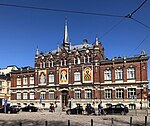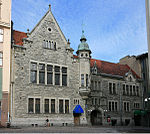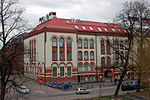Korkeavuorenkatu

Korkeavuorenkatu (Swedish: Högbergsgatan; literal translation, 'street of the high mountain') is a street in Helsinki, Finland. It runs north–south from Etelä-Esplanadi to the junction with Vuorimiehenkatu, where it becomes Kapteeninkatu. Its total length is approximately 860m (2,627 ft). The street is quite hilly, with two peaks, one at Erottaja Fire Station, and the other near the junction with Tarkk'ampujankatu. The section of the street from Etelä-Esplanadi to Yrjönkatu and Punanotkonkatu belongs to the Kaartinkaupunki district, and the rest to Ullanlinna. The houses are numbered from south to north, with odd numbers on the right and even on the left, facing north.
Excerpt from the Wikipedia article Korkeavuorenkatu (License: CC BY-SA 3.0, Authors, Images).Korkeavuorenkatu
Korkeavuorenkatu, Helsinki Kaartinkaupunki (Southern major district)
Geographical coordinates (GPS) Address Nearby Places Show on map
Geographical coordinates (GPS)
| Latitude | Longitude |
|---|---|
| N 60.163549 ° | E 24.946208 ° |
Address
Korkeavuorenkatu 25
00130 Helsinki, Kaartinkaupunki (Southern major district)
Finland
Open on Google Maps











